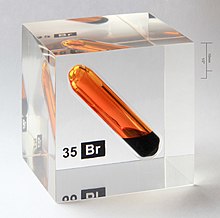 Liquid and gas bromine inside transparent cube | |||||||||||||||||||||
| Bromine | |||||||||||||||||||||
|---|---|---|---|---|---|---|---|---|---|---|---|---|---|---|---|---|---|---|---|---|---|
| Pronunciation | /ˈbroʊmiːn, -mɪn, -maɪn/ | ||||||||||||||||||||
| Appearance | reddish-brown | ||||||||||||||||||||
| Standard atomic weight Ar°(Br) | |||||||||||||||||||||
| |||||||||||||||||||||
| Bromine in the periodic table | |||||||||||||||||||||
| |||||||||||||||||||||
| Atomic number (Z) | 35 | ||||||||||||||||||||
| Group | group 17 (halogens) | ||||||||||||||||||||
| Period | period 4 | ||||||||||||||||||||
| Block | p-block | ||||||||||||||||||||
| Electron configuration | [Ar] 3d10 4s2 4p5 | ||||||||||||||||||||
| Electrons per shell | 2, 8, 18, 7 | ||||||||||||||||||||
| Physical properties | |||||||||||||||||||||
| Phase at STP | liquid | ||||||||||||||||||||
| Melting point | (Br2) 265.8 K (−7.2 °C, 19 °F) | ||||||||||||||||||||
| Boiling point | (Br2) 332.0 K (58.8 °C, 137.8 °F) | ||||||||||||||||||||
| Density (near r.t.) | Br2, liquid: 3.1028 g/cm3 | ||||||||||||||||||||
| Triple point | 265.90 K, 5.8 kPa[2] | ||||||||||||||||||||
| Critical point | 588 K, 10.34 MPa[2] | ||||||||||||||||||||
| Heat of fusion | (Br2) 10.571 kJ/mol | ||||||||||||||||||||
| Heat of vaporisation | (Br2) 29.96 kJ/mol | ||||||||||||||||||||
| Molar heat capacity | (Br2) 75.69 J/(mol·K) | ||||||||||||||||||||
Vapour pressure
| |||||||||||||||||||||
| Atomic properties | |||||||||||||||||||||
| Oxidation states | −1, +1, 2,[3] +3, +4, +5, +7 (a strongly acidic oxide) | ||||||||||||||||||||
| Electronegativity | Pauling scale: 2.96 | ||||||||||||||||||||
| Ionisation energies |
| ||||||||||||||||||||
| Atomic radius | empirical: 120 pm | ||||||||||||||||||||
| Covalent radius | 120±3 pm | ||||||||||||||||||||
| Van der Waals radius | 185 pm | ||||||||||||||||||||
| Other properties | |||||||||||||||||||||
| Natural occurrence | primordial | ||||||||||||||||||||
| Crystal structure | orthorhombic | ||||||||||||||||||||
| Speed of sound | 206 m/s (at 20 °C) | ||||||||||||||||||||
| Thermal conductivity | 0.122 W/(m⋅K) | ||||||||||||||||||||
| Electrical resistivity | 7.8×1010 Ω⋅m (at 20 °C) | ||||||||||||||||||||
| Magnetic ordering | diamagnetic[4] | ||||||||||||||||||||
| Molar magnetic susceptibility | −56.4×10−6 cm3/mol[5] | ||||||||||||||||||||
| CAS Number | 7726-95-6 | ||||||||||||||||||||
| History | |||||||||||||||||||||
| Discovery and first isolation | Antoine Jérôme Balard and Carl Jacob Löwig (1825) | ||||||||||||||||||||
| Isotopes of bromine | |||||||||||||||||||||
| |||||||||||||||||||||
Bromine is a chemical element with the symbol Br and atomic number 35. It is a volatile red-brown liquid at room temperature that evaporates readily to form a similarly coloured vapour. Its properties are intermediate between those of chlorine and iodine. Isolated independently by two chemists, Carl Jacob Löwig (in 1825) and Antoine Jérôme Balard (in 1826), its name was derived from the Ancient Greek βρῶμος (bromos) meaning "stench", referring to its sharp and pungent smell.
Elemental bromine is very reactive and thus does not occur as a free element in nature. Instead, it can be isolated from colourless soluble crystalline mineral halide salts analogous to table salt, a property it shares with the other halogens. While it is rather rare in the Earth's crust, the high solubility of the bromide ion (Br−) has caused its accumulation in the oceans. Commercially the element is easily extracted from brine evaporation ponds, mostly in the United States and Israel. The mass of bromine in the oceans is about one three-hundredth that of chlorine.
https://en.wikipedia.org/wiki/Bromine


No comments:
Post a Comment